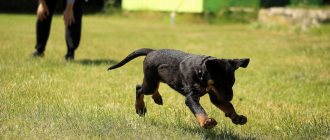The dog stopped obeying: the problem is with the owner
If you are patient and persistent, nothing should stop you - not the breed characteristics or the dog’s past life (if you bought it as an adult or adopted it from a shelter), nor gender, size or age.
To do this, you don’t have to be a professional dog handler (but you need to get one to help). The main thing is to take a responsible approach to raising and training your dog.
Many of us have probably at least once asked ourselves the question: how to make a dog obey, why do some owners have dogs that are gold, while others are real fiends of hell? As paradoxical as it sounds, if the dog stops obeying, the problem is with the owner.
The thing is that all owners are different, each has their own approach to education and training, and some have no approaches at all. Some know how and manage to react in a timely manner to the dog’s incorrect behavior and try to eliminate possible causes, analyze and correct their mistakes in the training process. Others are unwilling or unable to do this, leaving things to chance, which causes even bigger problems.
The most naughty dog breeds
Based on statistical data and numerous studies, Columbia University psychology professor S. Koren compiled a rating of dog breeds in order of their trainability.
The most naughty dog breeds:
- Basset Hound. This medium-sized dog breed is known for its unusual appearance, sad eyes, and huge, drooping ears. Bassets have a well-developed hunting instinct and a keen sense of smell. Despite its inherent intelligence, the Basset Hound has its own ideas about training and education. The owner can spend hours teaching his pet basic commands. If the dog doesn't want to do something, you won't get anything from him.
- Beagle. One of the ancient dog breeds. This is not to say that beagles are stupid and poorly trained, these dogs are simply stubborn and independent. They are incredibly loyal to their owners and require increased attention from their owners.
- Pekingese. Despite its small size, this breed is distinguished by its independent, willful, and domineering character. These dogs are stubborn and refuse to do anything they don't want to do. You should not demand the impossible from the Pekingese, trying to teach him complex commands. Still, this is a decorative dog breed that is very loyal to its owners.
- Mastiff. Despite their good-natured disposition, although these large dogs are endowed with intelligence, they differ from other breeds in their stubbornness and often show disobedience. Without experience, entrust your pet's training to a dog trainer.
- Bloodhound. Experts involved in dog training unanimously note that this breed is naturally endowed with a wayward, stubborn disposition. Bloodhounds can be considered a mystery breed. They have an excellent sense of smell, follow the scent, recognizing the subtlest odors, but show stubbornness when learning and following commands.
- Russian greyhound. A freedom-loving breed with a soft “cat-like” character. Dogs are active, curious, cheerful, but disobedient.
- Chow-chow. These dogs often behave the way they want. They are like cats that walk on their own. The dog understands what the owner requires of him, but often shows disobedience due to his innate stubbornness.
- Bulldogs. This breed seems to feel its aristocratic origin. These dogs were kept in the courts of noble people. Bulldogs are pampered, wayward, but very loyal pets. Doggies often change their mood. Training requires patience and must be systematic.
- Basenji. A rare and not very popular breed of dog. Dogs are active, inquisitive, independent, and spend a lot of time caring for themselves. Learning commands will require patience from the owner.
- Afghan Hound. In ancient times, these dogs were kept at the courts of Egyptian emperors and pharaohs. Involved in the hunt. Afghans are endowed with intelligence, but if they are fascinated by something, do not expect submission or obedience from your pet.
The rating given should not influence the choice of breed. Each animal is unique. And if a dog is not very trainable, this does not mean that he is devoid of gray matter.
It is not necessary for your pet to know all the commands. It is enough to instill the necessary skills and teach basic commands.
How to teach a dog to obey: rules for teaching order
Solving one specific problem, as a rule, will not improve the situation.
If the dog does not obey, it is necessary to change the entire system of relationships, only then can one hope for significant progress for the better.
Remember the following main rules for teaching order.
1. If necessary, punish the dog in a timely and correct manner (only at the time of committing the “crime” or immediately after it).
2. Your educational actions must be constant and decisive: if you prohibit something, then forever, and not from time to time.
3. Make the dog obey the first command given. If he doesn't respond, use reasonable punishment. This rule must be observed everywhere and always: at home, on a walk, in the process of training, education, etc.
4. Try to control the dog's behavior selectively when it is really necessary, without boring him with a huge number of commands.
5. If you give the dog a command, it must follow it. Once or twice, allow yourself to ignore the demand - and the first steps towards disobedience are guaranteed to you!
6. Do not prepare yourself for the fact that you will have to constantly jerk the dog, not allowing something and weaning it off something. Just from the very beginning, try to build relationships correctly according to the family hierarchy. Do not rely only on punishment: it is not always necessary, in most cases you can get by with other measures.
Freedom in the blood and a tendency to escape
In many ways, the character of a pet depends on genetics. Genetics, in turn, is determined by a person. We breed dogs for specific purposes. Some are ideal for hunting, others help save people. Certain traits are carefully maintained in the breed. Not all of them are convenient for owners. Some working animals enjoy freedom and rely less on a bond with their owner.
Which dogs should you take into your home with caution? There are always exceptions, but most often fugitives are found among pointers, hounds and sled breeds. Such pets must be trained from early childhood and their behavior must be constantly monitored. This is hard and painstaking work. Any mistake can lead to dire consequences, so it is better to think in advance about whether you can cope with an overly active dog.
How to make your dog obey: living by the rules
Don’t humanize the dog, don’t shower it with excessive affection, don’t surround it with excessive care, just create a life for it according to the rules, because everything is good in moderation. Excessive affection and guardianship can play a very bad joke on you: the dog will begin to exaggerate its importance - and then hold on.
If you are against physical punishment, that's not bad at all. But if the dog doesn't listen, in some cases a spank won't hurt.
Don’t blame your dog for your laziness or unwillingness to do everything regularly and systematically. Don't turn your life together into a nightmare. Just calmly and thoughtfully teach your dog how to live by the rules of your home. Physical punishment and yelling alone will not achieve anything.
Think about how clearly and correctly you understand the dog’s actions. She not only responds to commands, but is also able to sense your inner energy, feel emotions, and perceive intonations. Never yell at your dog or communicate with him in an excited state. And being offended by a dog is generally the height of human stupidity!
Do not keep your dog in a state of mental tension. So it’s not far from nervous breakdowns, as well as mental disorders. It is because of constant psychological oppression that a dog can pull on the leash, trying to run away, and not approach you on the command “Come to me!” Perhaps she feels bad with such an owner, she doesn’t want to see or hear you.
Exercises to improve recall
Sometimes, even following all the listed rules, the call is still not ideal. This is usually due to the fact that the dog is simply bored with monotonous training, and even a treat does not save the situation.
To make practicing the “Come” command more fun, diversify your lessons with fun exercises. They will not only break up boring workouts, but will also help develop automaticity.
You can find examples of exercises in the second part of the article - “7 exercises with the command “Come to me”: teaching the dog the ideal call .
Why does a dog not listen to its owner on the street?
What to do if the dog is mentally unbalanced, hyperactive, gets dirty in the house, constantly demands food from the table, does not listen, is afraid or, conversely, terrorizes everyone? What to do if at home the dog follows commands, but outside the dog does not comply? What to do if the dog “flies” on a leash, constantly climbs somewhere and rows something? Somehow follows commands at home, but not at all on the street? What to do if the dog does not obey the owner to such an extent that he can bare his teeth or even bite, and barks for hours when alone? These and many other questions constantly worry dog owners.
Try using a cage. Lock your dog in it when you leave home and at night when you are sleeping and cannot control its behavior. Prohibit sleeping on beds, armchairs and chairs. If possible, remove the dog from these places; when trying to occupy them, use the firm command “No!” If the dog is very obsessive, try to ignore it, then there is a chance that the dog will wait for you to pay attention to him. Set a timed feeding schedule, observing the system of holding before eating. Teach your dog to be clean and to move properly on a leash. The main thing is to understand yourself, your possible mistakes and shortcomings. Everything will definitely work out if you really try to understand the dog and really want to help him. Dogs, as a rule, are very smart creatures and are well aware of many tricks and ways to influence a person. Get ready for this!
If the dog runs away from home
In certain circumstances, a dog can easily run away from home. The most common reasons for running away:
- long absence of the owner;
- the presence of an open window, a balcony on the lower floors of the apartment;
- congenital or acquired fearfulness of the pet;
- sharp sounds outside the house;
- the presence of extraneous irritants - odors, animals running nearby, distracting passers-by.
If the dog is in foster care or has a previous owner, the animal may try to run away to find its previous home. If you are adopting an adult pet, it is important to build a good relationship and walk it well. Basic ways to prevent running away from home:
- securely close windows and front doors;
- ensure good physical activity, quality walking of the pet;
- leave a treat so that the animal has something to do;
- if a thunderstorm or fireworks explosions are planned (for the New Year), it is recommended to lock the animal in a small room without windows.
Treats can be hidden around the apartment to keep your pet interested while you are away. Various bones are effective, requiring a lot of time to crack them. After your return, your four-legged friend should always be rewarded for good behavior. Being alone should be taken calmly; the dog must be accustomed to this from puppyhood - left alone in the house, gradually increasing the duration.
How to make a dog obey: understand the reasons
If the dog does not obey, be sure to understand the reasons why this is happening. Either she really doesn't want to comply, or she doesn't understand what you want from her. Try to use other teaching methods and techniques, try to approach the educational process not in a stereotyped way, but creatively. If the reason for disobedience is the dog's unwillingness to obey, analyze how you fit into the status of a leader by asking yourself the following questions.
Why do obedience problems arise? There are many reasons. For example, no one is involved in raising and training a dog, its life is left to chance, the dog learns everything on its own. You forgive and allow him everything, and when this becomes a problem, you think about the current situation.
As you can see, it's not that simple. The main thing is to understand the reasons for the dog’s disobedience and start working on raising both him and yourself. If you can gather your strength, everything will work out!
Results about disobedience
One of the most important reasons for disobedience is fear of the leader. If you are too impudent, cold and aggressive, then the dog is simply afraid of you. Even if you are in a bad mood and somewhere took out your anger on the dog, it will constantly think that it is she who is the cause of your dissatisfaction and irritation.
Even when she approaches you, she will be scared, with her head down and her eyes drooping. Try playing together, hugging and petting the animal. Maybe you should give her a treat, just not for the team. Praise her for coming to you. Create situations where the animal will feel loved and needed. This will bring much more positive emotions to the relationship than from swearing and aggression. And always remember that the more anger you show, the greater the chance that one day the pet will break loose and attack you with a retaliatory blow. Evil begets evil, and good begets good, remember this.
Currently reading:
- Recommendations for obedience of a dog if it growls
- Games to choose for training a dog
- The American Cocker Spaniel is an adroit hunter and loyal friend.
- Tips for proper dog burial
Correcting puppy behavior
Correcting a puppy’s behavior involves a set of measures that will help eliminate unwanted behavioral skills in the pet. In essence, this is the education of animals, based on the use of praise, encouragement, and punishment.
Important! Education, unlike training, is a more complex, time-consuming process. With the right systematic approach, you can raise not only an obedient, controllable dog, but also a loyal friend and companion.
Behavior correction is necessary:
- For hyperactive, overly excitable puppies, dogs with an active psyche.
- If the puppy shows aggression towards people, family members, relatives, animals.
- If the dog is not properly socialized.
- If a puppy has fears, phobias, he behaves inappropriately when exposed to strong stimuli. For example, the dog is afraid of other dogs, cars, fireworks, loud noises.
- The puppy has destructive (destructive) behavior. The dog chews furniture and turns over the apartment in the absence of the owners.
- In case of uncleanliness of the dog, if the puppy craps in the house.
Choosing a collar for a rowdy
A leash, muzzle, and collar are indispensable attributes for walking and training dogs. The choice of collar depends on the breed, size, character traits, and temperament of the dog. Pay attention to the quality parameters of the material.
Important! The collar should be comfortable for the dog and fit in size.
- For disobedient medium and large dogs, wide canvas, leather collars, leatherette collars with durable fasteners and a welded steel ring are suitable for daily walks. The ring should be removed from the clasp.
- For small dogs - walking harness, strap models made of elastic soft leather.
- For training, practicing commands, and correcting behavior, purchase a strict collar (parfos), a choke collar or half-choke, in which the loop is not fully tightened around the dog’s neck. Choke collars are made of fabric materials, leather, metal (snatch chains). Half-chokes can be made from a combination of leather and metal.











